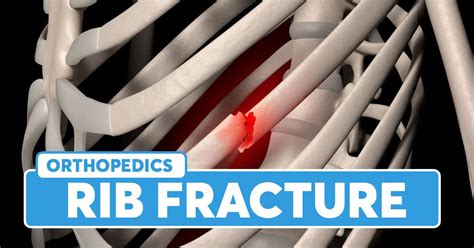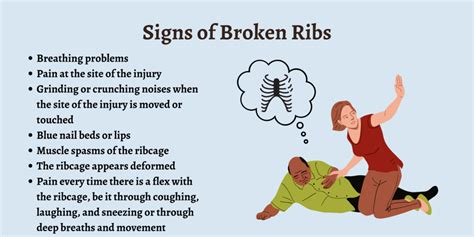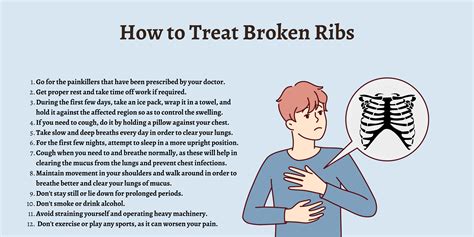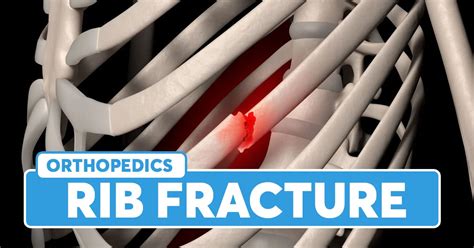Intro
Identify signs of a broken rib, including sharp chest pain, bruising, and difficulty breathing. Learn symptoms, causes, and treatment options for rib fractures and injuries, and when to seek medical attention for a suspected broken rib or rib cage injury.
The human body is capable of withstanding a significant amount of stress and pressure, but there are limits to its endurance. One of the most common injuries that can occur due to blunt trauma or severe coughing is a broken rib. The ribs are a vital part of the skeletal system, providing protection to the internal organs and helping with breathing. When a rib is broken, it can be a painful and potentially serious condition that requires immediate medical attention. In this article, we will explore the signs of a broken rib, its causes, symptoms, diagnosis, treatment, and prevention.
A broken rib, also known as a rib fracture, can be caused by a variety of factors, including falls, car accidents, sports injuries, and severe coughing. The severity of the break can vary, ranging from a small crack to a complete break. In some cases, the broken rib can puncture the lung or damage other internal organs, which can be life-threatening. It is essential to recognize the signs of a broken rib to seek medical help promptly.
The symptoms of a broken rib can vary depending on the severity of the injury. Some common signs include severe chest pain, difficulty breathing, bruising or swelling on the chest, and limited mobility. In some cases, the pain may worsen with deep breathing, coughing, or movement. If the broken rib has punctured the lung, symptoms may include shortness of breath, rapid breathing, or coughing up blood. It is crucial to monitor the symptoms and seek medical attention if they worsen or persist.
Causes Of A Broken Rib

The causes of a broken rib can be divided into two main categories: traumatic and non-traumatic. Traumatic causes include falls, car accidents, sports injuries, and physical assaults. Non-traumatic causes include severe coughing, osteoporosis, and cancer. In some cases, a broken rib can be caused by a combination of factors, such as a pre-existing medical condition and a traumatic event. Understanding the causes of a broken rib can help prevent such injuries and promote early detection.
Types Of Rib Fractures
There are several types of rib fractures, including: * Hairline fracture: a small crack in the rib * Stress fracture: a fracture caused by repeated stress or strain * Compression fracture: a fracture caused by compression or squeezing of the rib * Displaced fracture: a fracture where the bone is out of place * Non-displaced fracture: a fracture where the bone is still in placeEach type of fracture requires different treatment and management. It is essential to seek medical attention to determine the type and severity of the fracture.
Symptoms Of A Broken Rib

The symptoms of a broken rib can vary depending on the severity of the injury. Some common signs include:
- Severe chest pain
- Difficulty breathing
- Bruising or swelling on the chest
- Limited mobility
- Pain when moving or twisting
- Pain when coughing or sneezing
- Shortness of breath
- Rapid breathing
- Coughing up blood
It is crucial to monitor the symptoms and seek medical attention if they worsen or persist. In some cases, the symptoms may be mild, and the person may not realize they have a broken rib.
Diagnosis Of A Broken Rib
Diagnosing a broken rib typically involves a physical examination, medical history, and imaging tests. The doctor may: * Perform a physical examination to check for tenderness, bruising, or swelling * Take a medical history to determine the cause of the injury * Order imaging tests, such as X-rays, CT scans, or MRI scans, to confirm the diagnosis * Check for other injuries, such as a punctured lung or damaged internal organsEarly diagnosis and treatment can help prevent complications and promote recovery.
Treatment Of A Broken Rib

The treatment of a broken rib depends on the severity of the injury. Some common treatments include:
- Pain management: over-the-counter pain medications or prescription pain medications
- Rest and relaxation: avoiding strenuous activities and getting plenty of rest
- Breathing exercises: deep breathing exercises to help expand the lungs
- Physical therapy: exercises to help improve mobility and strength
- Surgery: in some cases, surgery may be necessary to repair the broken rib or damaged internal organs
It is essential to follow the doctor's instructions and attend follow-up appointments to ensure proper healing and prevent complications.
Prevention Of A Broken Rib
Preventing a broken rib can be challenging, but there are some steps that can be taken to reduce the risk. Some common prevention strategies include: * Wearing protective gear, such as seatbelts or helmets, when engaging in high-risk activities * Avoiding falls by using handrails, non-slip mats, and proper lighting * Maintaining good bone health through a balanced diet and regular exercise * Managing underlying medical conditions, such as osteoporosis or cancer * Avoiding severe coughing by getting vaccinated against flu and pneumoniaBy taking these steps, individuals can reduce their risk of breaking a rib and promote overall health and well-being.
Complications Of A Broken Rib

A broken rib can lead to several complications, including:
- Pneumothorax: a punctured lung
- Hemothorax: bleeding in the chest cavity
- Hemoptysis: coughing up blood
- Infection: pneumonia or other infections
- Chronic pain: ongoing pain or discomfort
It is essential to seek medical attention promptly to prevent these complications and promote recovery.
Recovery From A Broken Rib
Recovering from a broken rib can take several weeks or months. Some common recovery strategies include: * Following the doctor's instructions * Attending follow-up appointments * Taking pain medications as directed * Engaging in breathing exercises and physical therapy * Avoiding strenuous activities * Getting plenty of restBy following these strategies, individuals can promote healing, prevent complications, and regain their strength and mobility.
Conclusion And Next Steps

In conclusion, a broken rib is a serious condition that requires prompt medical attention. By understanding the signs, causes, symptoms, diagnosis, treatment, and prevention of a broken rib, individuals can take steps to reduce their risk and promote recovery. If you suspect you have a broken rib, seek medical attention immediately. With proper treatment and care, you can recover from a broken rib and regain your strength and mobility.
We invite you to share your experiences or ask questions about broken ribs in the comments section below. Your feedback and engagement are valuable to us, and we look forward to hearing from you.
What are the common causes of a broken rib?
+The common causes of a broken rib include falls, car accidents, sports injuries, and severe coughing. In some cases, a broken rib can be caused by a combination of factors, such as a pre-existing medical condition and a traumatic event.
What are the symptoms of a broken rib?
+The symptoms of a broken rib include severe chest pain, difficulty breathing, bruising or swelling on the chest, and limited mobility. In some cases, the symptoms may be mild, and the person may not realize they have a broken rib.
How is a broken rib diagnosed?
+A broken rib is typically diagnosed through a physical examination, medical history, and imaging tests, such as X-rays, CT scans, or MRI scans. The doctor may also check for other injuries, such as a punctured lung or damaged internal organs.
What is the treatment for a broken rib?
+The treatment for a broken rib depends on the severity of the injury. Some common treatments include pain management, rest and relaxation, breathing exercises, physical therapy, and surgery. It is essential to follow the doctor's instructions and attend follow-up appointments to ensure proper healing and prevent complications.
How can I prevent a broken rib?
+Preventing a broken rib can be challenging, but there are some steps that can be taken to reduce the risk. Some common prevention strategies include wearing protective gear, avoiding falls, maintaining good bone health, managing underlying medical conditions, and avoiding severe coughing.
